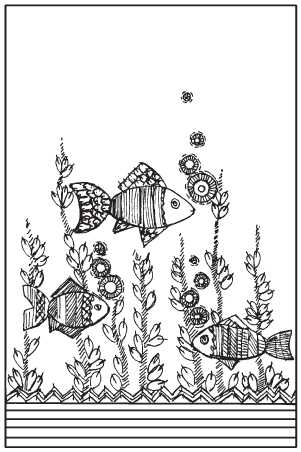Paintings and murals by stitch, the original interior decoration. Work in the technique of the shadow surface are easily mistaken for watercolors. Pictures can be inserted into the frame from under the photos. Glass it is better to remove, as it slightly distorts the embroidery.
Often the same pattern is available to decorate a completely different product. So, many plant motifs suitable for tablecloths, napkins and curtains, scarves and clothing.
You'll need
Thick linen cloth or crinoline cream color, length 115 cm, width 55 cm, thread floss 6 and 10 twists of orange, red, yellow, blue, green colors; satin ribbons red, blue and yellow colors with a width of 2 cm, a length of 110 and 55 cm; embroidery needle; diagram of the pattern in full size; water-soluble marker.
Progress
On a crisp linen, or crinoline cream color at a distance of 12 cm from the bottom edge
position the pattern. To move it from the diagram by using a water soluble marker.
The embroidery surface is used, the invoice grid, strings, loops and polumetally with pakracani, lace up, seam "forward needle".
In the first phase of operation, seam "forward needle" panel the contours of the stripes on the body of the fish. Each stitch on the front side start exactly from the point the end of the previous stitch, making the inside stitches 2 times longer than on the front. After that fish, located in the left corner, do the embroidery, mesh overlay, stitch "shoelace" knot.
Strips complete gladeville stitches, placing them across the body. Make them red, orange, yellow and blue thread in 2 additions. The fins and tail embroider orange thread. Long stitches in alternate fins are short. Tail embroider overlay grid. Make stitches along the tail. Then on top of embroider stitches are only in the transverse direction. At intersections make crosses. The head of the fish, scroll stitch "shoelace" thread of orange color 2 addition. First, make simple stitches around the contour of the head, then each stitch obvate thread. On the spot eye blue thread embroider lace up. Pulling thread with a needle on the front side and, holding it horizontally, make it around 2-3 loop the working thread from left to right. Print the thread out and tighten the knots, moving them to the fabric.
The second fish, located in the lower right corner, embroider satin stitch "lace" and lace up.
Make scalloped strips, placing stitches of different lengths across the body. The stacks perform in the orange-yellow-green spectrum. Tail embroider satin stitch the yellow and green threads. Stitches run along the tail alternately thread yellow (3 stitch) and green (2 stitch) flowers.
The contour of the head make the lace yellow thread, eye — burl green. Stripes on the body of the 3rd fish embroider exactly the same as the 1st. The fins and tail make eyes and polypetalae with pakracani thread orange and green colors 2 addition.
Withdraw the needle with the working thread on the front side and form a loop. Then slide the needle into the fabric near the beginning stitch and pull it there in the middle of the loops. Make prakrama little simple stitch. The remaining loops perform exactly the same. Instead of eyes embroider lace up yellow thread in 2 additions. Head select seam "lace".
The zigzag bands in the bottom panel embroider polypetalae yellow and orange thread in 2 additions. They embroider exactly the same as loops, but with a difference. Match polumetally and stick the needle at some distance from the beginning stitch.
The strands of seaweed lay stalked seam, and fluffy branches — loops with pakracani. All algae perform of green and yellow thread in 2 additions.
Air bubbles embroider Welt stitch blue thread in 2 additions. The outline of the bubble panel seam "forward needle". In the middle make a puncture with a thick needle. Further, the panel aperture edge seam "circle". Place the stitches close to each other, bending the fabric on the wrong side.
Fold the top and bottom sections of the panels 2 times on the wrong side and hem a hidden seam. To the bottom of the panel sew a satin ribbon. Red and blue ribbon pre-cut into 2 equal parts. To the edge sew the red band, then blue and yellow. Over the yellow, place the blue and close the strips of red ribbon. Tuck on the wrong side of the side edges of the panels 2 times and a hidden hem stitch (Fig. 68).




